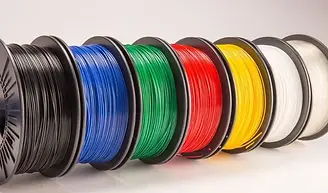Materials for 3D printing
Your success is our priority. Therefore, with Bulgaria 3D Print, high quality is standard. Our 3D farm operates and is refilled only with the highest quality filaments. With us you can find a diverse assortment of FDM (Fused Deposition Modeling) filaments for any need. Learn more about each type of material below and choose the most suitable one for your 3D part.

Most commonly used:
PLA (Polylactic Acid)

PLA (Polylactic Acid) is a biodegradable polyester made up of lactic acid blocks. This material is widely used in 3D printing and offers the following properties:
1. Melting point: 150 to 160 °C.
2. Cold injection step temperature: 60-65 °C.
3. Density: 1.210–1.430 g·cm−3 .
4. Tensile modulus: 2.7–16 GPa.
5. Solubility: PLA is soluble in chlorinated solvents, hot benzene, tetrahydrofuran and dioxane, but is not soluble in water.
How is PLA produced?
Lactic acid can be produced by bacterial fermentation of a selected carbohydrate source (such as corn starch, cassava root, or sugar cane). This process makes PLA production sustainable and renewable.
To produce high-density PLA, lactic acid is heated in the presence of an acid catalyst to form cyclic lactide. Using metal catalysts, lactide undergoes a ring-opening polymerization process to produce high-density PLA.
Advantages of PLA:
Biodegradability: PLA is environmentally friendly as it degrades naturally.
Sustainable production process: PLA is produced from renewable sources.
Low toxicity and safety for bioabsorption make it suitable for biomedical applications.
Availability in a variety of colors and ease of use make it a preferred choice for beginners and prototyping.
Choose PLA for your 3D project and create unique details with Bulgaria 3D Print! 🚀
Commonly used: ASA (Acrylonitrile Styrene Acrylate)

ASA (Acrylonitrile Styrene Acrylate) is a thermoplastic material similar to ABS but with improved heat resistance and strength. ASA is strong and stable, with exceptional UV resistance, not yellowing with prolonged exposure to the sun. This makes it extremely suitable for outdoor or industrial applications.
Advantages of ASA:
Resistance to atmospheric influences and UV rays: ASA retains its gloss, color and mechanical properties even after prolonged exposure to external conditions.
Resistance to environmental stress cracking: ASA has greater resistance to cracking than ABS, which prevents thermoplastic products from becoming brittle under mechanical stress and chemical exposure.
Resistance to heat and chemical degradation: ASA copes well with high temperatures and chemical effects.
Gloss and antistatic properties: ASA products have a pleasant gloss, high impact resistance and antistatic properties.
Acetone polishing capability: ASA can be polished with the usual 3D printing polishing agent - acetone. You can polish ASA stamps as you would ABS stamps.
How to work with ASA? The settings for printing with ASA are very similar to those you would normally use for ABS. This means printing at high temperatures, perhaps even beyond the capabilities of some printer models.
Choose ASA for your 3D project and create unique details with Bulgaria 3D Print! 🚀
Soft material: TPU (ThermoPlastic Polyurethane)

TPU (ThermoPlastic Polyurethane) is a thermoplastic material that is often used in 3D printing to create flexible parts. Here are some of the properties of TPU:
Flexibility and softness: TPU is an extremely flexible material that can stretch to twice its original length and return to its original shape without permanent deformation.
Shock resistance and vibration damping: The flexible nature of TPU makes it excellent at absorbing strong shocks and reducing vibrations.
Ideal for flexible prototypes: Prototypes that need to be tested and curved are ideal for 3D printing with TPU.
Abrasion resistance: TPU handles wear and tear well and has been shown to perform well even at low temperatures.
Applications: TPU is used for sporting goods, medical devices, shoes, inflatable boats, outer cases for mobile devices and car dashboards. It is also used in industrial applications due to its resistance to oils, fats and various solvents.
Ease of handling: TPU is easier to process than TPE (ThermoPlastic Elastomer). The hardness of TPU (94A) makes it more suitable for 3D printing mechanisms.
Layer to layer adhesion of TPU is generally excellent due to its soft nature. This means that seals made from TPU are extremely strong and durable
Choose TPU for your 3D project and create unique details with Bulgaria 3D Print! 🚀
Soft material: ABS (Acrylonitrile Butadiene Styrene)

ABS (Acrylonitrile Butadiene Styrene) is probably the most commonly used filament for 3D printing. It is particularly valuable for creating strong plastic parts that must remain resistant to temperature fluctuations. ABS is mainly used in FDM (fused deposition modeling) 3D printers.
Composition of ABS filament:
ABS is a copolymer composed of three monomers: acrylonitrile, butadiene and styrene.
Acrolonitrile gives it hardness, chemical resistance and strength.
Styrene provides a smooth and shiny texture.
Butadiene is the flexible part that makes ABS impact resistant.
Properties of ABS filament:
High heat resistance: ABS can withstand high temperatures.
Exceptional impact resistance: Parts made of ABS are durable and can withstand multiple impacts.
Impact resistance even at low temperatures.
Excellent melt flow: ABS filaments melt evenly and solidify without additional processing.
Good resistance to abrasion and stress.
Choose ABS for your 3D project and create unique details with Bulgaria 3D Print! 🚀